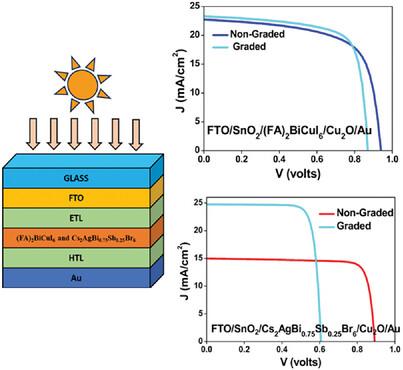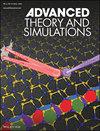Theoretical Optimization and Comparison of (FA)2BiCuI6 and Cs2AgBi0.75Sb0.25Br6 Based Double Perovskite Solar Cells
IF 2.9
4区 工程技术
Q1 MULTIDISCIPLINARY SCIENCES
引用次数: 0
Abstract
To overcome the issue of toxicity in lead (Pb) based perovskite solar cells, this work investigates, optimizes, and compares the performance of solar photovoltaic cells based on two different promising Pb-free double perovskite absorber materials viz. (FA)2BiCuI6 and Cs2AgBi0.75Sb0.25Br6. The optoelectronic properties of these materials indicate high absorption coefficient with minimum reflection coefficients, making them appropriate for photon absorption. The performance of (FA)2BiCuI6 and Cs2AgBi0.75Sb0.25Br6 based modeled cells are examined for several combinations of electron and hole transport materials using SCAPS-1D and the optimized power conversion efficiency (PCE) of 14.3% and 11.1% are achieved by simulating the architectures FTO/SnO2/(FA)2BiCuI6/Cu2O/Au and FTO/SnO2/Cs2AgBi0.75Sb0.25Br6/Cu2O/Au, respectively. Further, this work employs the bandgap grading scheme to enhance their PCEs. The efficiency of cells further improves to 14.8% and 12.2% credited to the reduction in interfacial recombination with bandgap graded absorber layers. Moreover, the comparative investigations are also done in terms of absorber layer defect density and working temperature. The findings provide valuable insights into designing of highly efficient Pb-free double perovskite solar cells as the promising alternative to conventional Pb based halide perovskite photovoltaic cells.

求助全文
约1分钟内获得全文
求助全文
来源期刊

Advanced Theory and Simulations
Multidisciplinary-Multidisciplinary
CiteScore
5.50
自引率
3.00%
发文量
221
期刊介绍:
Advanced Theory and Simulations is an interdisciplinary, international, English-language journal that publishes high-quality scientific results focusing on the development and application of theoretical methods, modeling and simulation approaches in all natural science and medicine areas, including:
materials, chemistry, condensed matter physics
engineering, energy
life science, biology, medicine
atmospheric/environmental science, climate science
planetary science, astronomy, cosmology
method development, numerical methods, statistics
 求助内容:
求助内容: 应助结果提醒方式:
应助结果提醒方式:


